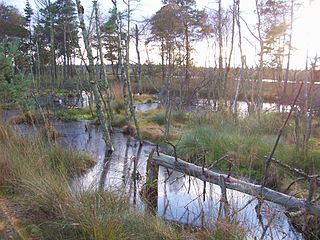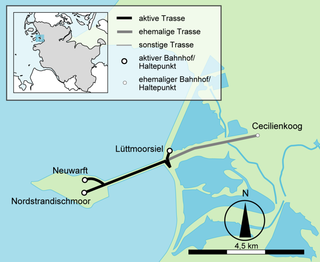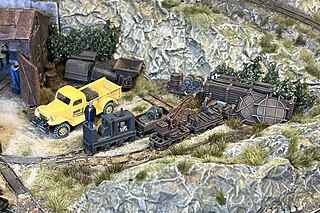The War Department Light Railways were a system of narrow gauge trench railways run by the British War Department in World War I. Light railways made an important contribution to the Allied war effort in the First World War, and were used for the supply of ammunition and stores, the transport of troops and the evacuation of the wounded.

The Froissy Dompierre Light Railway is a 600 mm narrow gauge light railway running from Froissy to Dompierre-Becquincourt, through Cappy, in the Somme department, France. It is run as a heritage railway by APPEVA and is also known as P'tit Train de la Haute Somme. It is the last survivor of the 600 mm narrow gauge trench railways of the World War I battlefields.

The Murtalbahn is a 760 mm narrow-gauge railway largely located in the state of Styria in Austria. The line runs along the valley of the River Mur, from the market town of Unzmarkt through Murau to Tamsweg, which is just over the Styrian border in the state of Salzburg. The railway is operated by Steiermärkische Landesbahnen (STLB), which is owned by the state of Styria. With a total length of 76.1 km (47.3 mi), it is the fourth-longest narrow-gauge railway in Austria.

A Heeresfeldbahn is a German or Austrian military field railway. They were field railways (Feldbahnen) designed for the military transportation purposes.

The Spiegelau Forest Railway was a 600 mm narrow gauge forest railway built for the transportation of logs from the woods around Spiegelau in the Bavarian Forest in southern Germany.

The Burgsittensen Moor Railway is a 600 mm narrow gauge light railway or Feldbahn, which is based on an old peat line near Tiste on the Lüneburg Heath in North Germany.

Schöma is a company based in Diepholz, Germany, specialising in the construction of small diesel locomotives.

The Lüttmoorsiel-Nordstrandischmoor island railway, also called the Loren Railway, is a German, 600 mm narrow gauge island railway through the North Frisian Wadden Sea from Beltringharder Koog on the mainland to the Hallig of Nordstrandischmoor.
A number of narrow-gauge lines survive, largely as a consequence of German reunification, in the former East Germany where some of them form part of the public transport system as active commercial carriers. Most extensive of those still employing steam traction is the Harz mountain group of metre-gauge lines, the Harzer Schmalspurbahnen. Other notable lines are the Zittau–Oybin–Jonsdorf line in Saxony, the Mollibahn and the Rügensche Kleinbahn on the Isle of Rügen on the Baltic coast and the Radebeul-Radeburg line, Weisseritztalbahn in the suburbs of Dresden. Although most rely on the tourist trade, in some areas they provide significant employment as steam traction is particularly labour-intensive.
Numerous industrial narrow-gauge lines were built for peat extraction, clay extraction for brickworks and construction sites. The dominant gauge for industrial lines was 700 mm, contrary to the 600 mm gauge used in neighbouring countries.

Around 1935, Latvian narrow-gauge railways consisted of 536 km of 600 mm gauge, 432 km of 750 mm gauge, and 48 km of meter gauge.
Lithuania has 158.8 km of 750 mm narrow-gauge railway lines remaining, although only 68.4 km of them are regularly used, employing 12 locomotives. They are included in the Registry of Immovable Cultural Heritage Sites of Lithuania.
Europe inherited a diversity of rail gauges. Extensive narrow-gauge railway networks exist in Spain, Central Europe and Southeastern Europe.
The Swakopmund–Windhoek line was a main 600 mm narrow-gauge railway line in Namibia. It was built in 1897 and operated until 1990 when the route name was changed.

The Wiesloch Feldbahn and Industrial Museum is a narrow-gauge railway and industrial heritage open-air museum established in 2001, at Wiesloch, Germany. The museum is centred around the former locomotive shed of the Tonwaren-Industrie Wiesloch (TIW) brickworks, and houses industrial equipment from large excavators to small machine tools, plus large and small locomotives.

The Riedlhütte narrow-gauge railway is a not for profit light railway in Sankt Oswald-Riedlhütte in the Bayerischer Wald.

Tonwaren-Industrie Wiesloch was a brickworks making which existed in Wiesloch, Germany between 1895 and 1989. It was one of the largest and most significant factories in Germany. The factory was located just north of Wiesloch-Walldorf station and was the largest employer in Wiesloch.

H0f gauge, occasional as H0i gauge designated, is a rail transport modelling scale representing Feldbahn-style 2 ft and 600 mm gauge railways using 1:87 HO scale running on Z gauge 6.5-millimetre (0.26 in) track. The Normen Europäischer Modellbahnen NEM 010 specification defines H0f for modelling gauges 400–650 millimetres (16–26 in), as part of the 1:87-scale family that includes narrow-gauge railway models using H0e gauge and metre-gauge railway models using H0m gauge.

The Iwanowo light railway was an approximately 170 km (110 mi) long military light railway with a track gauge of 600 mm from Ivatsevichy via Iwanowo to Kamin-Kashyrskyi with two branch lines to the area west of Pinsk.






















